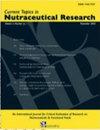Isoalantolactone Regulates the Activity of Mitogen-Activated Protein Kinases and Nuclear-Factor Erythroid 2-Related Factor 2 Pathways to Attenue Angiotensin II-Induced Cardiomyocyte Hypertrophy and Oxidative Stress
IF 0.4
4区 医学
Q4 NUTRITION & DIETETICS
引用次数: 0
Abstract
While isoalantolactone is a sesquiterpene lactone known for its anti-inflammatory and antioxidant activities, its role in cardiac hypertrophy is unknown. This study aimed to explore the role and mechanism of isoalantolactone in cardiomyocyte hypertrophy using angiotensin II-treated H9C2 cells as a model. The Western blot analysis was used to evaluate changes in the cardiac hypertrophy marker proteins atrial natriuretic peptide and brain natriuretic peptide and the activity of nuclear-factor erythroid 2-related factor 2/mitogen-activated protein kinase signaling pathway. Rhodamine-phalloidin staining was used to measure the surface area of cardiomyocytes. Apoptosis and intracellular reactive oxygen species levels were measured by flow cytometry. The results showed that isoalantolactone inhibited angiotensin II-induced H9C2 cell hypertrophy and cardiomyocyte apoptosis and reduced intracellular reactive oxygen species and cytochrome C levels in a dose-dependent manner. Furthermore, isoalantolactone upregulated the nuclear factor erythroid 2-related factor 2/heme oxygenase-1 and inhibited extracellular signal-regulated kinase, c-Jun NH2-terminal kinase, and p38 (a stress-stimulated kinase) activation. Collectively, the findings suggest that isoalantolactone can enhance the antioxidant capacity of H9C2 cells, reduce apoptosis, and inhibit cardiac hypertrophy, and these protective effects may be related to the regulation of nuclear-factor erythroid 2-related factor 2 and mitogen-activated protein kinase pathway activity by isoalantolactone.异丙氨酸内酯调节有丝分裂原活化蛋白激酶和核因子红细胞2相关因子2的活性以减轻血管紧张素II诱导的心肌细胞肥大和氧化应激
异丙氨酸内酯是一种倍半萜内酯,以其抗炎和抗氧化活性而闻名,但其在心脏肥大中的作用尚不清楚。本研究以血管紧张素II处理的H9C2细胞为模型,探讨异丙氨酸内酯在心肌细胞肥大中的作用及其机制。Western印迹分析用于评估心肌肥大标记蛋白心房钠肽和脑钠肽的变化以及核因子红系2相关因子2/丝裂原活化蛋白激酶信号通路的活性。罗丹明-鬼笔素染色法测定心肌细胞的表面积。流式细胞术检测细胞凋亡和细胞内活性氧水平。结果表明,异丙氨酸内酯以剂量依赖的方式抑制血管紧张素II诱导的H9C2细胞肥大和心肌细胞凋亡,并降低细胞内活性氧和细胞色素C水平。此外,异丙氨酸内酯上调核因子红系2相关因子2/血红素加氧酶-1,并抑制细胞外信号调节激酶、c-Jun NH2末端激酶和p38(一种应激刺激激酶)的激活。总之,研究结果表明,异丙氨酸内酯可以增强H9C2细胞的抗氧化能力,减少细胞凋亡,抑制心肌肥大,这些保护作用可能与异丙氨醇内酯对核因子红系2相关因子2和促分裂原活化蛋白激酶通路活性的调节有关。
本文章由计算机程序翻译,如有差异,请以英文原文为准。
求助全文
约1分钟内获得全文
求助全文
来源期刊
CiteScore
1.10
自引率
0.00%
发文量
36
审稿时长
>12 weeks
期刊介绍:
Current Topics in Nutraceutical Research is an international, interdisciplinary broad-based peer reviewed scientific journal for critical evaluation of research on chemistry, biology and therapeutic applications of nutraceuticals and functional foods. The major goal of this journal is to provide peer reviewed unbiased scientific data to the decision makers in the nutraceutical and food industry to help make informed choices about development of new products.
To this end, the journal will publish two types of review articles. First, a review of preclinical research data coming largely from animal, cell culture and other experimental models. Such data will provide basis for future product development and/or human research initiatives. Second, a critical evaluation of current human experimental data to help market and deliver the product for medically proven use. This journal will also serve as a forum for nutritionists, internists, neurologists, psychiatrists, and all those interested in preventive medicine.
The common denominator of all of the topic to be covered by the journal must include nutraceuticals and/functional food. The following is an example of some specific areas that may be of interest to the journal. i) Role of vitamins, minerals, antioxidants and phytonutrients on cardiovascular health, cancer, diabetes, ocular health, mental health, men’s health, women’s health, infant nutrition, ii) Role of herbals on human health, iii) Dietary supplements and sleep, iv) Components of diet that may have beneficial effect on human health, v) regulation of apoptosis and cell viability, vi) Isolation and characterization of bioactive components from functional foods, vii) Nutritional genomics, and viii) Nutritional proteomics.

 求助内容:
求助内容: 应助结果提醒方式:
应助结果提醒方式:


